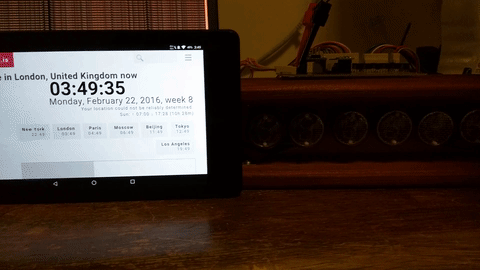##Motivation
Steins;Gate's Divergence meter
This project is based on this instructable by Andrea Biffi with modifications.
##Project structure
clock_firmware- firmware for our display(powered by Arduino Nano)esp8266_firmware- firmware for our ESP01 that handles NTP syncsrc- PCB design and schematics in DipTrace formattools- binaries for flashing the ESP01 WiFi moduledocs- various PDF datasheets for our components
##BOM Summary Main components
- IN4 Nixie tubes
- SN74141 BCD decoder IC
- Arduino Nano v3
- ESP01 esp8266 WiFi module
The BCD decoder IC and Nixie tubes is hard to obtain, so far they're only available on ebay and most of them are NOS(new old stock)
Check the schematics for the rest of the passives
##Theory of operation
###Display Unlike LED segment displays, Nixie tubes requires high voltage DC to illuminate. This poses a challenge as the decoder IC has to accommodate for this requirement, luckily, Texas Instrument has a jellybean solution that we can use. For cost considerations, we multiplex the tubes with 12 high power transistors.
###Architecture Arduino Nano drives all the displays. Nixie tubes are multiplexed and given a 2ms illumination interval. For 6 displays, this is equivalent to a refresh rate of ~83Hz. Time keeping is also done with the Nano, a basic serial API is exposed:
(Commands must be the start of line and prefixed with "@")
h<string>:<string> - heartbeat, returns the given string
s <long>:<bool> - set current time in millisecond
c:<long>- returns current time in milliseconds
r:<bool> - invalidate display now
t <int>:<bool> - display invalidate interval, default 1s (1000ms)
m <[c+(H|M|S|s)]|[s]>:<bool>- display mode for each display
ESP01 handles time synchronization via NTP through WiFi. The module is programmed to sync every hour with a predefined NTP server.
Nano and ESP01 communicates via serial. A software serial interface is also exposed on the Nano for debugging.
###Software
- Display firmware is written in C++ and compiled using the gcc-avr toolchain
- esp8266 firmware is written in lua running on top of the NodeMCU platform
##Firmware build instruction
###Clock firmware
- Download and setup Arduino software
- Navigate into
clock_firmware, open theclock_firmware.inofile - Connect your Arduino Nano to your computer
- Verify and flash
- Download the latest NodeMCU firmware
- Connect your ESP01 via USB TTL adapter
- Flash NodeMCU firmware using the Flasher tool in the
toolsdirectory - Start up ESPlorer(also located in
tools) - Load both
init.luaandntp.luafiles
##NTP sync
##Photos
Completed clock
 Board wiring
Board wiring
 Case prototype with PCB installed
Case prototype with PCB installed
 Back side of PCB
Back side of PCB
 Testing (@9V 121mA)
Testing (@9V 121mA)
 PCB exposed on the back
PCB exposed on the back
 HVDC prototype
HVDC prototype
 PCB
PCB
 Nixie display board socket assembly
Nixie display board socket assembly
 Display board assembly
Display board assembly
 Display board close up
Display board close up
 All PCB
All PCB
 All PCB close up
All PCB close up
 HVDC testing(300VDC)
HVDC testing(300VDC)

